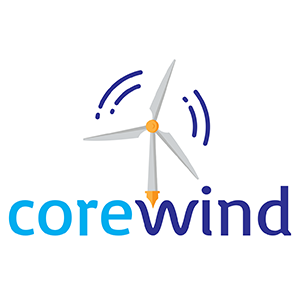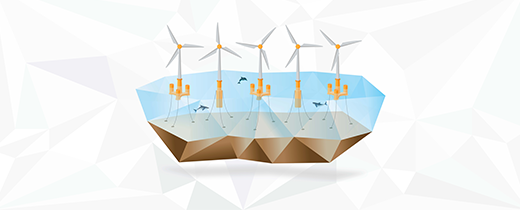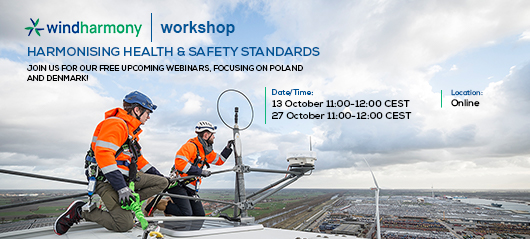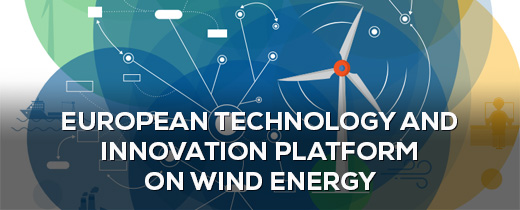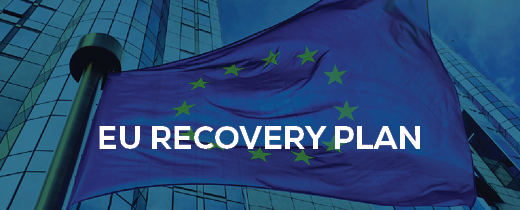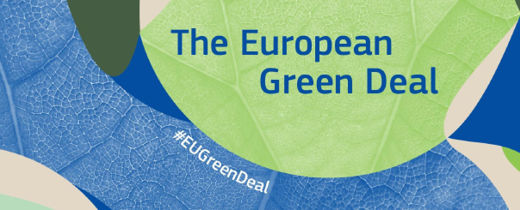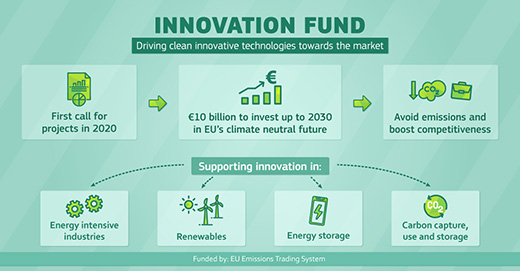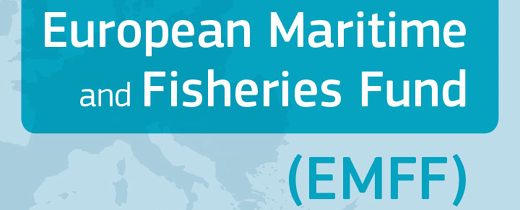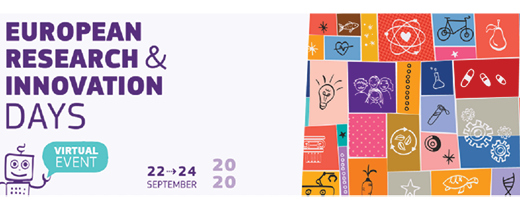Your gateway to WindEurope’s EU-funded projects, European Funding Opportunities and the latest on funding Policies.
News from WindEurope projects

The Corewind team has been working on a report on floating-wind-specific O&M requirements and monitoring technologies which is available to download on the Corewind website. The document identifies state-of-the-art techniques in order to enable economic O&M operations for future commercial floating wind farms.
The adhesion of proteins or microorganisms on wetted surfaces can influence the behaviour of the components submerged in the sea. Therefore, the COREWIND project has been analysing marine growth and biofouling in all system components (turbines, floating structures, mooring and dynamic cables). The project partners sent material samples for anchors and dynamic cables to the Marine Corrosion Test Site “El Bocal” located on the Cantabrian coast near Santander. The results will help validate the model assumptions for different components of the floating system.
Follow us on our social media accounts, Twitter and LinkedIn.
For more information, contact Sabina Potestio.
About Corewind: The COREWIND project provides disruptive and cost-effective solutions for floating offshore wind technology leading to cost reduction. It is developing innovative research, modelling and optimization for concrete-based floating substructure concepts.
Health and Safety (H&S) is a top priority for the wind industry. But how is it addressed in each country? Why does the industry need to follow different approaches and regulation to achieve the same goal? The project WindHarmony, funded by the European Commission, has been looking into these questions and has assessed the potential for harmonisation of H&S regulations and standards across Europe. The final results are available here. A series of best practice events were organised in September and October across Europe. Did you miss them? Don’t worry, you can access them here.
If you don’t have time to watch but would like a quick summary, read our latest post here.
After two years of intense industry discussions the project is now finished. There are 7 priority areas for potential harmonisation of H&S standards. And the consortium has developed a database on national H&S regulation that has been made publicly available.
For more information contact Sabina Potestio.
About WindHarmony: The Wind Harmony project looks at health and safety (H&S) regulations and related standards impacting onshore and offshore wind energy across in Europe. It assesses and prioritises their potential for harmonisation or other type of intervention at European level.

With accelerated policies, floating offshore wind could reach cost parity with bottom-fix offshore in the next decade, very much depending on the speed of deployment and research policies.
ETIPWind produced a graphic overview of the state-of-the-art floating offshore wind technology and the measures needed for commercialisation. The report spells out the sector's R&I recommendations allowing Europe to take the lead in a vast and untapped global market, as well as supporting European competitiveness. The topic was addressed in a webinar earlier this year. Did you miss it? See the video here.

For more information, contact Alexander Vandenberghe.
About ETIPWind: ETIPWind works to define and agree on concrete research and innovation (R&I) priorities and communicate these to the European institutions and other decision-making bodies in order to support the EU’s ambition of a decarbonised economy by 2050.

Permitting is today’s main bottleneck for new wind farms. It often takes 3 years or more for authorities to decide on a permit. These delays add to the costs of developing a wind farm, deter investors and stifle technological innovation.
WindEurope has joined forces with other renewable energy sectors and partners to tackle permitting issues in a 3-year project funded by the European Commission: the RES SIMPLIFY.
As a first step, the partners are mapping the permitting procedures in different countries. Secondly, we will monitor and evaluate the performance of these permitting procedures based on key performance indicators. The results of the monitoring and evaluation, in combination with other sources of good practice will then be used to identify transferable good practice approaches that should be reflected in the next revision of the Renewable Energy Directive and that can be applied in Member States.
WindEurope organised a workshop on 20 October with wind farm developers and national associations to identify the appropriate performance indicators to assess the efficiency and effectiveness of permitting processes in Member States. The participants validated the indicators proposed by the project partners. Some examples include cost of administrative/grid connection procedures, process duration, the average response time of authorities/TSOs/DSOs, the average number of staff in authorities to assess permits and the minimum distance to housing.
For more information, contact Sabina Potestio.
About RES Simplify: The RES SIMPLIFY project is a project funded by the European Commission on permitting of renewable energy. It is coordinated by the Consultancy Eclareon, partnering with Oeko-Institut, WindEurope and SolarPower Europe. The project aims to speed up the permitting process at a national level for new renewable energy projects, including onshore and offshore wind.
European Funding Opportunities & Policies

1. Recovery & Resilience Facility
The European Parliament’s position on the Recovery & Resilience Facility (RRF) was voted on in committee on 10 November. Negotiations between the European Parliament, European Commission and EU Council on the final form of the €672.5bn funding instrument are expected to be concluded by the year’s end. All three institutions agree that 37% of RRF funding should go to climate-related spending.
Five Member States have already published high-level Recovery & Resilience Plans (RRPs): Spain, Romania, Portugal, Czechia, and Slovenia (see graph below). The Romanian plan is the most ambitious as it represents up to 16% of gross national income while the Spanish plan represents the largest absolute amount, with €140bn planned.

The European Commission is currently engaged in discussions with these Member States on the details of their plans, to ensure they meet both the criteria in the draft RRF regulation, and the Commission guidance published in September. Final drafts of the RRPs should be ready by 30 April 2021 for evaluation by the European Commission.
2. InvestEU
Trilateral negotiations are also underway on InvestEU, the European Commission guarantee to de-risk loans from the European Investment Bank and other public financial institutions. The institutions are currently far apart. The European Parliament supports a budget of over €40bn, with guarantees provisioned at 45%, while the Council of the European Union supports a budget of just €9.4bn, with guarantees provisioned at 40%. The Council’s position makes no mention of the Strategic Investment Facility first proposed by the European Commission in May.
3. Just Transition Fund
On Wednesday Green MEPs managed to get rid of natural gas funding from the €17.5 billion Just Transition Fund (JTF) in the final round of trilogue negotiations. The European Commission and Council positions already excluded gas funding, but Parliament had approved an opinion in September allowing for fossil spending in regions expected to have a tough time switching from coal to renewables.
For rolling updates on the instruments and budget, please visit our WindEurope website.
If you have a project that wants to benefit from funding, contact Sabina Potestio.

On 11 November, EU members states approved the European Investment Bank (EIB) Group Climate Bank Roadmap 2021-2025.
The Roadmap describes how the EIB will support the objectives of the European Green Deal and sustainable development outside the European Union. This includes:
- Allocating €1 trillion in investment for climate action and environmental sustainability in the decade to 2030;
- EIB Group aligning all financing activities from the end of 2020 with the goals of the Paris Agreement;
- More than 50% of annual financing dedicated to green investment by 2025;
- More green advisory services and financing of innovative low carbon technologies;
- Support for green capital markets, climate change adaptation, Just Transition projects.
EIB President Werner Hoyer stated that the roadmap constitutes a significant contribution to the role of Europe which is leading the effort for decarbonisation and the building of a green, resilient economy leaving no one behind.
For more information, contact Guy Brindley.

The European Commission has opened a call for Research & Innovation projects, with a €1 billion budget under Horizon 2020, to help the EU deliver on the Green Deal in the form of grants. Funding is also available for wind energy. The call is open until 26 January 2021 and is subdivided into different topics:
More details about the call are available here.
In October, WindEurope organised a Sofa Talk with the European Commission’s experts, who gave us all necessarily tips and steering in helping proposals to succeed. A very insightful session. Our top recommendation for those involved in the current call. Did you miss it? Don’t worry, you can access the video here.
For more information, contact Sabina Potestio.

The Blue Economy Window is a “window” of opportunities in the form of grants, allocated to SME projects every year through the European Maritime and Fisheries Fund (EMFF).
This time around, it’s €20M for projects from SMEs contributing to the Green Deal goals. SMEs are considered the backbone of our economy and will play a huge role in the post-COVID recovery.
Relevant areas for the blue economy include renewable energy, cleaner shipping, digital transformation of ocean and coastal activities and enabling technologies such as sensors, corrosion or biofouling resistant materials, coating, digitisation, electricity transmission equipment or multi-purpose platforms.
The call is open until 16 February and aims at:
- Bringing to market new products, services, processes, and business models in blue economy value chains and helping to advance their market-readiness;
- Developing a sustainable and innovative blue economy in Europe's sea basins;
- De-risking investment in these projects to facilitate their access to other financing schemes for the next stages of their activities.
Who can apply?
Minimum of 1 for-profit SME from any EU Member State + the UK.
How much support can companies expect?
70% co-funding. Indicative requested contribution between €700,000 & €2,500,000
What is the EC looking for?
- Close-to-market activities (TRL 6-8);
- Innovation & impact-oriented investment;
- Strong management teams;
- Support from investors or customers.
Can these funds be combined with other EU funds?
No. Beneficiaries cannot simultaneously receive finance from other public sources.
For more information, contact Sabina Potestio.

One of the world’s largest funding programmes for the demonstration of innovative low-carbon technologies, the Innovation Fund has recently allocated €1bn to 311 projects including 58 on renewable energy (look out for the upcoming ETIPWind newsletter in January on R&I to get more information on wind projects!). This first call for projects was also 22 times oversubscribed! (projects worth €21.7 bn for only €1bn available). The fund has now opened a call for small-scale projects with less than €7.5m in CAPEX and has a budget of €100m to allocate.
The call will support innovative, state-of-the-art projects that go beyond incremental innovation and that support the Green Deal objectives. The deadline to apply is 10 March 2021.
What are the award criteria?
- Degree of innovation. If a proposal scores less than the minimum threshold under this criterion, the evaluation is stopped (the remaining criteria are neither evaluated nor scored);
- Project maturity and greenhouse gas emissions avoidance potential. If a proposal scores less than 50% of total points under the project maturity criterion, if it does not meet the minimum requirements or is found to have a manifest error under the greenhouse gas emission avoidance potential criterion, the evaluation is stopped (the remaining criteria are neither evaluated nor scored);
- Scalability and cost efficiency.
The funds can be used in cooperation with other public funding initiatives, such as State aid or other EU funding programmes.
Applicants will be informed about the results of the evaluation in the fourth quarter of 2021. Full info on the call can be found here. And you can listen to the info webinar here.
For more information, contact Sabina Potestio.

The European Commission has approved an investment package of more than €280 million from the EU budget for new LIFE programme projects. Among other challenges, these projects will support the EU Biodiversity Strategy to 2030, contribute to the EU’s Green recovery post-COVID-19, and help Europe become a climate-neutral continent by 2050.
The LIFE programme will become more and more important for wind as of 2021. A specific sub-programme on energy will be added to the budget line. So keep an eye on its upcoming funding opportunities next year!
For more information, contact Sabina Potestio.

Are you part of a European or national research project and you want to promote it? Would you like to attract new partners and disseminate your results? Look no further – we have the perfect solution for you. WindEurope’s Innovation Park is a pavilion designed to promote projects’ research and findings, and will feature at Electric City 2021 in Copenhagen (27-29 April). The goal of the pavilion is to provide high-profile visibility on the exhibition floor to projects, giving partners access to greater publicity and networking opportunities.
Benefits include:
- Your own exhibition space;
- A speaking slot on the Innovation Park stage;
- A printed logo on your exhibition space;
- Entry in the exhibitor list;
- Social media coverage;
- 2 Exhibitor staff passes (lunch included).
For more information, contact Tanguy Grandjean.
|
Legal notice: The views represented in this newsletter are those of its authors and do not represent the views or official position of the European Commission.
|
 |
